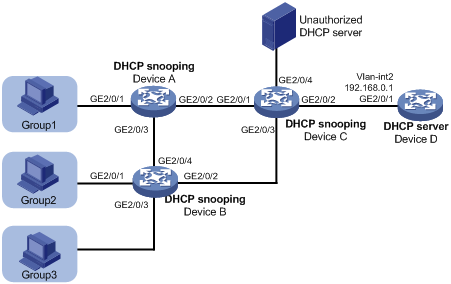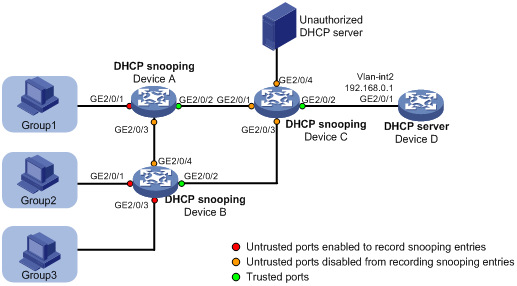- Table of Contents
-
- 04-Layer 3 - IP Services Configuration Examples
- 01-H3C_DHCP_Snooping_Configuration_Examples
- 02-H3C_GRE_with_OSPF_Configuration_Examples
- 03-H3C_GRE_Tunnel_Configuration_Examples
- 04-H3C_IPv6_over_IPv4_Manual_Tunneling_with_OSPFv3_Configuration_Examples
- 05-H3C_ISATAP_Tunnel_and_6to4_Tunnel_Configuration_Examples
- 06-H3C_IP_Unnumbered_Configuration_Examples
- 07-H3C_Cross-Subnet_Dynamic_IP_Address_Allocation_Configuration_Examples
- Related Documents
-
| Title | Size | Download |
|---|---|---|
| 01-H3C_DHCP_Snooping_Configuration_Examples | 86.73 KB |
H3C DHCP Snooping Configuration Examples
|
Copyright © 2017 New H3C Technologies Co., Ltd. All rights reserved. No part of this manual may be reproduced or transmitted in any form or by any means without prior written consent of New H3C Technologies Co., Ltd. The information in this document is subject to change without notice. |
|
Introduction
This document provides DHCP snooping configuration examples.
Prerequisites
The configuration examples in this document were created and verified in a lab environment, and all the devices were started with the factory default configuration. When you are working on a live network, make sure you understand the potential impact of every command on your network.
This document assumes that you have basic knowledge of DHCP.
Example: Configuring DHCP snooping
Network configuration
As shown in Figure 1, three groups of hosts are connected to the DHCP server through the DHCP snooping devices. Configure DHCP snooping and DHCP server to meet the following requirements:
· Hosts in each group obtain IP addresses from the address range assigned to the group. Assign address ranges to the groups as follows:
? Address range 192.168.0.2 to 192.168.0.39 for Group 1.
? Address range 192.168.0.40 to 192.168.0.99 for Group 2.
? Address range 192.168.0.100 to 192.168.0.200 for Group 3.
· The hosts can obtain IP addresses only from the authorized DHCP server.
· The hosts cannot access the network through IP addresses that are manually configured.

Analysis
To meet the network requirements, you must perform the following tasks:
· To make sure the hosts in each group obtain IP addresses from the address range assigned to the group, perform the following tasks:
? Configure Option 82 on the DHCP snooping devices.
? Create DHCP user classes for the groups and configure match rules based on Option 82 to match the groups on the DHCP server.
· To make sure the hosts obtain addresses only from the authorized DHCP server, configure ports facing the server as trusted and other ports as untrusted, as shown in Figure 2.
· To prevent illegal users from using manually configured IP addresses to access the network, perform the following tasks:
? Enable ARP detection in the VLANs where the groups reside to check user validity based on DHCP snooping entries.
? Enable recording of client information in DHCP snooping entries. To save system resources, you can enable only untrusted ports directly connected to hosts to record DHCP snooping entries, as shown in Figure 2.
Figure 2 Trusted and untrusted ports

Software versions used
This configuration example was created and verified on S7500E-X-CMW710-R7536P05.
Restrictions and guidelines
To ensure correct DHCP address allocation by using Option 82, you must perform Option 82 configuration on both the DHCP server and the DHCP snooping devices.
Procedures
Configuring Device A
# Enable DHCP snooping.
<DeviceA> system-view
[DeviceA] dhcp snooping enable
# Enable recording of client information in DHCP snooping entries on interface GigabitEthernet 1/0/1.
[DeviceA] interface GigabitEthernet 1/0/1
[DeviceA-GigabitEthernet1/0/1] dhcp snooping binding record
# Enable DHCP snooping to support Option 82 on interface GigabitEthernet 1/0/1. Configure the padding content for the Circuit ID sub-option as group1.
[DeviceA-GigabitEthernet1/0/1] dhcp snooping information enable
[DeviceA-GigabitEthernet1/0/1] dhcp snooping information circuit-id string group1
[DeviceA-GigabitEthernet1/0/1] quit
# Configure interface GigabitEthernet 1/0/2 as a trusted port. By default, an interface is an untrusted port.
[DeviceA] interface GigabitEthernet 1/0/2
[DeviceA-GigabitEthernet1/0/2] dhcp snooping trust
[DeviceA-GigabitEthernet1/0/2] quit
# Enable ARP detection for user validity check.
[DeviceA] vlan 1
[DeviceA-vlan1] arp detection enable
[DeviceA-vlan1] quit
# Configure interface GigabitEthernet 1/0/2 as an ARP trusted port. By default, an interface is an ARP untrusted port.
[DeviceA] interface GigabitEthernet 1/0/2
[DeviceA-GigabitEthernet1/0/2] arp detection trust
[DeviceA-GigabitEthernet1/0/2] quit
Configuring Device B
# Enable DHCP snooping.
<DeviceB> system-view
[DeviceB] dhcp snooping enable
# Enable recording of client information in DHCP snooping entries on interface GigabitEthernet 1/0/1.
[DeviceB] interface GigabitEthernet 1/0/1
[DeviceB-GigabitEthernet1/0/1] dhcp snooping binding record
# Enable DHCP snooping to support Option 82 on interface GigabitEthernet 1/0/1. Configure the padding content for the Circuit ID sub-option as group2.
[DeviceB-GigabitEthernet1/0/1] dhcp snooping information enable
[DeviceB-GigabitEthernet1/0/1] dhcp snooping information circuit-id string group2
[DeviceB-GigabitEthernet1/0/1] quit
# Configure interface GigabitEthernet 1/0/2 as a trusted port. By default, an interface is an untrusted port.
[DeviceB] interface GigabitEthernet 1/0/2
[DeviceB-GigabitEthernet1/0/2] dhcp snooping trust
[DeviceB-GigabitEthernet1/0/2] quit
# Enable recording of client information in DHCP snooping entries on interface GigabitEthernet 1/0/3.
[DeviceB] interface GigabitEthernet 1/0/3
[DeviceB-GigabitEthernet1/0/3] dhcp snooping binding record
# Enable DHCP snooping to support Option 82 on interface GigabitEthernet 1/0/3. Configure the padding content for the Circuit ID sub-option as group3.
[DeviceB-GigabitEthernet1/0/3] dhcp snooping information enable
[DeviceB-GigabitEthernet1/0/3] dhcp snooping information circuit-id string group3
[DeviceB-GigabitEthernet1/0/3] quit
# Enable ARP detection for user validity check.
[DeviceB] vlan 1
[DeviceB-vlan1] arp detection enable
[DeviceB-vlan1] quit
# Configure interface GigabitEthernet 1/0/2 as an ARP trusted port. By default, an interface is an ARP untrusted port.
[DeviceB] interface GigabitEthernet 1/0/2
[DeviceB-GigabitEthernet1/0/2] arp detection trust
[DeviceB-GigabitEthernet1/0/2] quit
Configuring Device C
# Enable DHCP snooping.
<DeviceC> system-view
[DeviceC] dhcp snooping enable
# Configure interface GigabitEthernet 1/0/2 as a trusted port. By default, an interface is an untrusted port.
[DeviceC] interface GigabitEthernet 1/0/2
[DeviceC-GigabitEthernet1/0/2] dhcp snooping trust
[DeviceC-GigabitEthernet1/0/2] quit
Configuring Device D
# Assign interface GigabitEthernet 1/0/1 to VLAN 2.
<DeviceD> system-view
[DeviceD] vlan 2
[DeviceD-vlan2] port GigabitEthernet 1/0/1
[DeviceD-vlan2] quit
# Assign an IP address to VLAN-interface 2.
[DeviceD] interface Vlan-interface 2
[DeviceD-Vlan-interface2] ip address 192.168.0.1 24
[DeviceD-Vlan-interface2] quit
# Enable DHCP.
[DeviceD] dhcp enable
# Enable DHCP server on VLAN-interface 2.
[DeviceD] interface vlan-interface 2
[DeviceD-Vlan-interface2] dhcp select server
[DeviceD-Vlan-interface2] quit
# Create DHCP user class group1 for hosts in Group 1. Configure match rule 1 to match DHCP requests in which the third to eighth bytes of Option 82 is 0x67726F757031. The string 0x67726F757031 indicates that the content of the Circuit ID sub-option is group1.
[DeviceD] dhcp class group1
[DeviceD-dhcp-class-group1] if-match rule 1 option 82 hex 67726F757031 offset 2 length 6
[DeviceD-dhcp-class-group1] quit
# Create DHCP user class group2 for hosts in Group 2. Configure match rule 1 to match DHCP requests in which the third to eighth bytes of Option 82 is 0x67726F757032. The string 0x67726F757032 indicates that the content of the Circuit ID sub-option is group2.
[DeviceD] dhcp class group2
[DeviceD-dhcp-class-group2] if-match rule 1 option 82 hex 67726F757032 offset 2 length 6
[DeviceD-dhcp-class-group2] quit
# Create DHCP user class group3 for hosts in Group 3. Configure match rule 1 to match DHCP requests in which the third to eighth bytes of Option 82 is 0x67726F757033. The string 0x67726F757033 indicates that the content of the Circuit ID sub-option is group3.
[DeviceD] dhcp class group3
[DeviceD-dhcp-class-group3] if-match rule 1 option 82 hex 67726F757033 offset 2 length 6
[DeviceD-dhcp-class-group3] quit
# Create a DHCP address pool.
[DeviceD] dhcp server ip-pool 1
# Specify the subnet for dynamic address allocation.
[DeviceD-dhcp-pool-1] network 192.168.0.0 mask 255.255.255.0
# Specify address range 192.168.0.2 to 192.168.0.39 for DHCP user class group1.
[DeviceD-dhcp-pool-1] class group1 range 192.168.0.2 192.168.0.39
# Specify address range 192.168.0.40 to 192.168.0.99 for DHCP user class group2.
[DeviceD-dhcp-pool-1] class group2 range 192.168.0.40 192.168.0.99
# Specify address range 192.168.0.100 to 192.168.0.200 for DHCP user class group3.
[DeviceD-dhcp-pool-1] class group3 range 192.168.0.100 192.168.0.200
# Apply the DHCP address pool to VLAN-interface 2.
[DeviceD] interface Vlan-interface 2
[DeviceD-Vlan-interface2] dhcp server apply ip-pool 1
[DeviceD-Vlan-interface2] quit
Verifying the configuration
# Verify that the hosts in each group can obtain IP addresses from the address range assigned to the group. This example uses a host in Group 2 to verify the configuration.
C:\Documents and Settings\Administrator>ipconfig
Windows IP Configuration
Ethernet adapter bb:
Connection-specific DNS Suffix . :
IP Address. . . . . . . . . . . . : 192.168.0.44
Subnet Mask . . . . . . . . . . . : 255.255.255.0
Default Gateway . . . . . . . . . :
# Manually assign IP address 192.168.0.66 to a host in Group 2, and verify that it cannot access the external network. (Details not shown.)
Configuration files
· Device A:
#
dhcp snooping enable
#
vlan 1
arp detection enable
#
interface GigabitEthernet1/0/1
port link-mode bridge
dhcp snooping binding record
dhcp snooping information enable
dhcp snooping information circuit-id string group1
#
interface GigabitEthernet1/0/2
port link-mode bridge
arp detection trust
dhcp snooping trust
#
· Device B:
#
dhcp snooping enable
#
vlan 1
arp detection enable
#
interface GigabitEthernet1/0/1
port link-mode bridge
dhcp snooping binding record
dhcp snooping information enable
dhcp snooping information circuit-id string group2
#
interface GigabitEthernet1/0/2
port link-mode bridge
arp detection trust
dhcp snooping trust
#
interface GigabitEthernet1/0/3
port link-mode bridge
dhcp snooping binding record
dhcp snooping information enable
dhcp snooping information circuit-id string group3
#
· Device C:
#
dhcp snooping enable
#
interface GigabitEthernet1/0/2
port link-mode bridge
dhcp snooping trust
#
· Device D:
#
dhcp enable
#
vlan 2
#
dhcp class group1
if-match rule 1 option 82 hex 67726f757031 offset 2 length 6
#
dhcp class group2
if-match rule 1 option 82 hex 67726f757032 offset 2 length 6
#
dhcp class group3
if-match rule 1 option 82 hex 67726f757033 offset 2 length 6
#
dhcp server ip-pool 1
network 192.168.0.0 mask 255.255.255.0
class group1 range 192.168.0.2 192.168.0.39
class group2 range 192.168.0.40 192.168.0.99
class group3 range 192.168.0.100 192.168.0.200
#
interface Vlan-interface2
ip address 192.168.0.1 255.255.255.0
dhcp server apply ip-pool 1
#
interface GigabitEthernet1/0/1
port link-mode bridge
port access vlan 2
#
Related documentation
· H3C S7500E-X Switch Series Layer 3—IP Services Configuration Guide-R7536P05
· H3C S7500E-X Switch Series Layer 3—IP Services Command Reference-R7536P05

